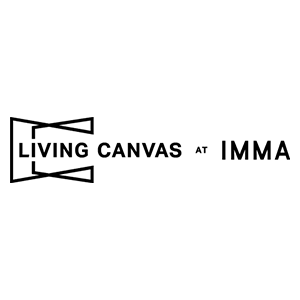Dwelling in the interval of time that bridges one year to the next, this programme – Tilt the interval – is shaped by questions of interruption. In a world filled with disordered narratives, the artists’ works wrangle arrangements of their own. The films articulate new practices for narrating unfixed environments. They tilt the structures that inevitably slip: speech, writing, rehearsal, technology, and film materiality.
This screening features five emerging Irish and international artists working in film and moving image, and is guest curated by Screen Service for Living Canvas at IMMA. Screen Service is a service-oriented organisation that has been supporting artists primarily in or from Ireland since 2022 and is co-directed by Ellen O’Connor and Bronagh Gallagher.
Tilt the interval is curated by Ellen O’Connor and includes works by Holly Pickering, Elinor O’Donovan, Lucy Tevlin in collaboration with Ben Malcolmson, alyene, Olivia Normile.
Films in order of appearance:
Holly Pickering, An Apprenticeship, 2025| 09:25 minutes
Elinor O’Donovan, Convivo, 2025| 10:29 minutes
Lucy Tevlin, LO-TEK, 2025| 09:30 minutes
alyene, œrystɯla, (or örüstyla), 2022| 07:11 minutes
Holly Pickering, Actor, 2025| 06:21 minutes
Olivia Normile, Limits and Demonstrations, (Loop Two), 2025| 04:23 minutes
About the films:
Holly Pickering
An Apprenticeship, 2025
Colour, sound, 09:25 minutes
An Apprenticeship takes its title from Brazilian novelist Clarice Lispector’s ‘An Apprenticeship Or The Book Of Pleasures/Un Apprentissage, Ou, Le Livre Des Plaisirs’ in which the protagonist questions how to bridge the gap between herself and others. In this moving-image work, a nameless character addresses two synchronized cameras, offering disparate statements and posing questions to the viewer. Filmed against a photography backdrop, the image gestures toward staged scenes and audition tapes, drawing upon ideas of authenticity, rehearsal and performance. The script holds together text from Lispector’s novel, LinkedIn notifications, iPhone prompts, email etiquette and social cues, reflecting upon how we navigate our sense of self amidst the pervasive influence of mass media and the modern emphasis on ‘marketing one’s character’.
The sound reconfigures Jeff Buckley’s song ‘So Real’, and the ’X song but you are in a bathroom at a party’ internet trend, popularised during the COVID 19 pandemic – in which pop songs were edited to sound as though coming from another room – muffled and distant, drowned out by the ambient chatter of an imagined social setting. An Apprenticeship circulates around the contemporary struggle and desire for intimacy, calling attention to the quiet anxieties of self-presentation.
Elinor O’Donovan
Convivo, 2025
Colour, sound, 10:29 minutes
Convivo is a film about the rhythms of living together, with other people and with the more–than–human world. Filmed in a former school in the Kaunu region of northern Finland, the film lingers in empty rooms, following small details in the library, bedrooms, sitting rooms and kitchen. Colourful flecks of confetti appear and disappear, suggesting the presence of others, beings and ways of being that cannot be fully known. Subtitles give voice to insects, birds, and the spectral presence of former residents, while occasionally humans are glimpsed through windows or heard in distant rooms. The film reflects on conviviality as a way of being, where coexistence is an ongoing, shifting practice rather than a fixed state.
Lucy Tevlin
LO-TEK, 2025
Audio by Ben Malcolmson
Colour, sound, 09:30 minutes
LO-TEK is a digitised 16mm film produced in 2024 during Tevlin’s residency with Harkat Studios, situated in the mountainous region of Kalimpong in the Himalayas, West Bengal, India. The film was developed and printed by hand using experimental contact printing processes. In harmony with the mountainous landscape, buildings are depicted nestled into steep slopes and are constructed using materials that are both readily available and manufactured. The film reflects on the sharing of traditional ecological and technological knowledge systems, questioning historical Western ideas of progress and the mythology of technology.
Ben Malcolmson’s Untitled Soundscape #1, 2025, is a responsive audio piece to Tevlin’s LO-TEK, exploring themes of place, land, and human presence through a multilayered soundtrack. Archival field recordings, distant hums, and fragmented voices merge with the tactile textures of celluloid tape.
Alyene
œrystɯla, (or örüstyla), 2022
Colour, sound, 07:11 minutes
The title of this work – œrystɯla, (or örüstyla) – translates as “language of the river.” Drawing connections between the land, the Sakha language, and the practice of relating to both animate and inanimate beings, the work evokes the inseparability of environment, consciousness, and body. Through the reclamation of animistic cosmologies passed down from previous generations, it brings attention to the former script of Sakha culture. The video incorporates historical references to an early Sakha writing system, taking imagery from a 1919 primary school textbook.
Holly Pickering
Actor, 2025
Colour, sound, 06:21 minutes
Actor uses women’s competitive gymnastics as a lens to explore broader societal demands on femininity. The work compiles archival footage, including Nadia Comăneci’s 1976 performance, where she became the first gymnast to score a perfect 10.0 ( a score displayed as “1.00” due to the limitations of the scoreboard); an interview with Kerri Strug discussing her 1996 Olympic vault on a broken ankle, securing gold for the U.S. team in tandem with ending her gymnastics career; and scans of the FIG Code of Points.
Olivia Normile
Limits and Demonstrations, (Loop Two), 2025
Colour, 04:23 minutes
Cold glass, dust settles, spots in motion.
A blurring of autobiographical moments and staged reenactments, this film enacts a disconnect and delay of sight and memory. A gathering of scenes, questioned, their commonalities reconsidered and woven together. Sight altered, memory fades; each frame carries a slight delay, as though recalled from underwater or from the edge of the peripheral. Limits and Demonstrations reaches into the microscopic, spotlighting the details that precede recognition, the hesitant gestures that form before understanding has time to settle.
This film originally formed part of a Platform Commission for the 41st EVA International.
About the artists
Holly Pickering is an artist from Waterford currently based in Dublin. Her practice moves between moving-image, publication-making, and writing to explore questions surrounding communication. Her practice is attuned to human behaviours and the ways in which social conventions mediate emotions, gestures, and speech as they unfold within interpersonal interactions. Drawing on cinematic, literary, and pop cultural references is central to how these concerns are articulated.
Elinor O’Donovan speculates playful responses to questions about knowledge, memory and truth. Working primarily in film and installation, she emphasises the ways stories shape our understanding of ourselves and the worlds we inhabit, using humour to interrogate the blurred boundaries between fact and fiction. Drawing heavily on pop cultural references and tropes, she recontextualises shared symbols to question what assumptions they may impart. Playfulness is key to her methodology, using visual wit to engage with complex themes such as personal identity and western cultural myths. She has exhibited in solo and group shows across Ireland, the UK, Portugal, Italy, South Korea, and Mexico. Solo exhibitions include: Metametamorphosis, 36 Gallery, Newcastle, (2026); The Immeasurable Grief of the Prawn, GeneratorProjects, Dundee (2023); Brain Worms, Sample-Studios at the Lord Mayor’s Pavilion, Cork (2021); and Brain Worms: Redux, 126 Gallery, Galway (2021). Selected commissions include: Crawford Art Gallery and Cork Midsummer Festival (2024); and Island City: Cork’s Public Art Trail, commissioned by the National Sculpture Factory and Cork City Council (2023). She is a recipient of the Arts Council of Ireland Visual Arts Bursary (2024, 2023, 2022, 2021), and the Cork Midsummer Festival Jane Anne Rothwell Award (2024). In 2024, Elinor O’Donovan was shortlisted for the Golden Fleece Award.
Lucy Tevlin is a visual artist based in Dublin. Her practice is shaped by a conceptual approach to image making. She uses image, text, film, and found materials to methodically interrogate the spatial, mechanical, and historical properties of photographic technologies. Her work examines how images are made, presented, and distributed, primarily using apparatus on the brink of obsolescence. The subject matter of her work is often referential to the medium used. Her practice inquires into the nature of representation, temporality, technological progress, and acts of looking.
Ben Malcolmson is a visual artist and curator from Belfast and based in Dublin. His fine art practice explores the parameters of photography, video, and sculpture using alternative photographic processes with relation to one’s land and identity. His curatorial interests encompass social engagement and activism through a public-centred approach, particularly for young people.
alyene is a visual artist from the Sakha Republic. She has ancestral ties to both the Kolyma region and the central part of the republic, and was raised in Zyryanka and Yakutsk. Her practice engages themes of continuity, displacement, gaps, and absences within the cultural memory of the Sakha people and related northern communities. Drawing on personal and familial histories alongside state archives and media, she reflects on how Indigenous identities and memories are shaped, silenced, and reclaimed.
Olivia Normile is an artist exploring language, communication, and perception through animation, installation, and experimental film. Activated by an interest in the peripheral, this layering of methods allow for an exchange of roles and narratives. Animals frequently appear as central figures in her work, acting as counterpoints to the human perspective. Her installations and films often stage quiet exchanges between species and systems unfolding through gaps and omissions.
About the guest curators:
Screen Service is a service-oriented organisation supporting artists in or from Ireland. Through collaboration and flexible formats, projects are produced that prioritise experimentation, connectivity and artist-led development. With a focus on media and interdisciplinary approaches, Screen Service works with artists across all disciplines to expand possibilities in critically engaged practice. Co-directed by Ellen O’Connor and Bronagh Gallagher.
Ellen O’Connor is a curator and producer from Co. Louth. She builds responsive frameworks for inquisitive artistic exchange and career support. Often developing projects that unfold across online and physical spaces, her work interlaces themes of correspondence, rehearsal and duality.


